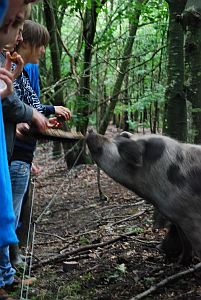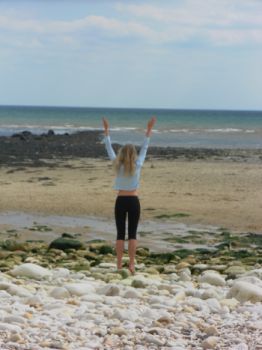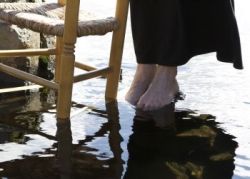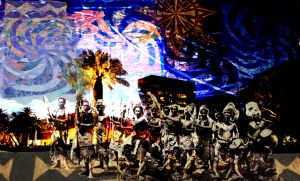Special sessions

Tuesday, July 2nd:
Pig or porc, cow or beef. Alienation from the origins of meat
Organizers: Elles Kiers, Dinanda Luttikhedde (PeerGrouP), Hinke Haisma, Sanne Visser
In contemporary Western society, with its abundance of processed and fast foods, people are alienated from the origin of food. However, meanings given to food change over time, and differ between cultures and geographic regions.
In Tanzania, for example, eating meat is associated with festivities. A goat or a cow, depending on the importance of the guest or the occurrence, is slaughtered. The slaughtering is a very delicate process where each part of the animal is handled preciously and used for different purposes. Goat blood is a special food given to women right after birth as a treat and a source rich in iron to replace blood lost during delivery. A piece of beef will be cut by the head of the household, and the first piece of meat handed over to the guest. There is a lot of ceremony in the way food and eating is being dealt with.
In contrast, in the Netherlands, eating animals has been reduced to buying pieces of meat, packaged in plastic, in the supermarket. And only the best parts of the animal can be recognized as such in the stores. Intestines, eyes, bone marrow are processed into products where the animal nature of it cannot be recognized. In general, the process of slaughtering has become detached from the beauty of preparing, and many people choose to exclude from their imaginations the animal nature of their meal, to exclude that beef was once cow, and pork once pig.
In this special session, artists and scientists come together to present and discuss issues related to meanings and emotions associated with the production and consumption of food in different parts of the world. A central element in this session is the project Pig House by Dutch PeerGrouP artists. The presentation by the PeerGrouP is contextualised in a discussion about geographic and cultural differences related to the meaning of meat consumption.
The Pig House connects theatre and the arts, both visually and tastefully, with agriculture and livestock breeding. A key aim of the project is to draw attention to the origin of our food, the living and often loved animal. In doing so, it brings food closer to the people both conceptually and literally.
Since 2010 the Peergroup have kept 4 pigs in Donderen and all of them were given a name. After 7 months the artists Elles Kiers and Sjef Meyman decided to slaughter one of the animals. On an early morning, Bom was taken to a butcher’s and a few days later he was collected in 2 pieces for further preparation. It was an exciting and at times emotional journey through Bom’s body. The process was followed carefully by filmmakers Dinanda Luttikhedde and Nelleke Koop. Their documentary “Blood” shows the transformation from a loved animal to a tasteful snack. It has been presented at several film festivals in the Netherlands and outside.
For the purpose of this session, Dinanda Luttikhedde (PeerGrouP) is developing a documentary featuring the three Pig Houses in the Netherlands, one of which is located in Annerveensche Kanaal in the Veenkoloniën, one of the most socio-economically deprived, rural areas in the Netherlands. This is also the location of an ongoing research project on the meaning of food by Visser and Haisma. The Pig House in Annerveensche Kanaal is a sty, a home for pigs, and has also become a house for locals to gather, to eat, drink and talk. The documentary explores how the Pig Houses have become embedded into local communities, and how the presence of these pig houses has potentially influenced the meanings given to meat in these communities.
The session is organised in a way that will create an understanding of how eating meat is closely related to caring for animals and the (ceremonial) nature of slaughtering, preparing and serving. Therefore, the session is structured as follows:
- BLOOD / documentary film 15 min;
- Introduction of meanings of food in different cultures;
- Stories on ceremonies and rituals in relation to meat consumption from Annerveensche Kanaal and Tanzania – Elles Kiers, Hinke Haisma;
- Fragments of the unreleased documentary “PIGHOUSE” – Dinanda Luttikhedde;
- Porc tasting – prepared by artist and cook Elles Kiers
- Discussion

Wednesday, July 3rd:
Dwelling on the Shoreline: Suze Adams and Victoria Hunter
I am rooted but I flow
Virginia Wolff, The Waves
This session brings together two visual/performing artists whose research practices centre around the rich and complex concept of dwelling and whose works, each in their own distinctive ways, explore relationships between land and sea, body and water. Drawing from a range of multi-disciplinary sources, the session will focus on artworks and creative processes that seek to challenge traditional boundaries in order to examine embodied experience and to question where and how we might dwell.
The session will start with a presentation from each of the artists: in her paper, Dancing the Beach: in-between land, sea and sky, Victoria Hunter will examine how felt experience and emotionally embodied responses to land and sea are explored by choreographers through translation into expressive movement and gesture. Informed by spatial and phenomenological theory, her paper will consider how this type of site-dance work explores interstitial territories created through bodily movement on, through and within coastal landscapes and considers emotional resonances and sensations invoked through and housed within the practice.

Drawing upon the author’s practice-led research and the work of practitioner-researchers engaging in site-dance work in coastal locations, using visual examples the paper seeks to question what occurs when a dancing body becomes engaged, immersed and enfolded within this type of landscape and will consider what this type of work can reveal about human processes of being and dwelling within coastal locations.
Similarly exploring the inter-relationship between body and water, in her presentation, Drawn to Water, Suze Adams will screen a film from her research project Communion. Originally performed on the Hebridean Isle of Mull, home to Suze’s maternal ancestors, the film is the visual outcome of a research practice that examines the concept of dwelling and notions of home as a route to exploring and extending multi-sensory understandings of the lived environment. In order to contextualise the film, Suze will briefly discuss other exploratory projects situated in the littoral. Inspired by the harsh and enchanting landscapes of Mull and recognising the mutability of identity, time and home, Communion unpicks the concept of dwelling and expands on a place-called-home with reference to feminist theories of becoming. Here dwelling is translated as embodied potential (a form of situated becoming) and, carrying such understandings forward, Communion considers the permeability of boundaries between the elemental and the material, between the physical and psychological actualities of the lived environment.
Together Suze and Victoria open up a range of understandings of dwelling: challenging, dissolving, expanding and questioning the concept in image, movement and word. Firmly grounded in the materiality of the physical landscape, these artists explore and examine embodied experience balancing all the while between the felt and the seen, the known and the understood, the abstract and the concrete, the fluid and the solid. The presentations will be followed by an informal conversation between Suze and Victoria who will pick up on convergent (and divergent) threads. The session will then open out into Q&A/discussion in order to develop conceptual as well as practical research themes. The session will be chaired by Dr Owain Jones.
Dr Victoria Hunter is a Practitioner-Researcher and Lecturer in Dance at the University of Chichester, U.K and Dr Suze Adams is an independent research artist based in the UK.

An Archaeology of Race at the Museum: Theatres of Pain: Performing an exploration of Post-Imperial Affective politics at the 21st century museum
Rosanna Raymond and Divya P. Tolia-Kelly
Museum displays effect and are forged through affective politics. When world cultures were framed in the 19th century, often underlying them were accounts of taxonomies of race where European bodies, affective capacities and sensibilities were defined as the best that humanity could achieve and offer. Theatres of Pain is a debut (filmed) performance by Divya Tolia-Kelly and Rosanna Raymond reflecting their long term collaboration on thinking through 'how can 21st century museum displays of Polynesian cultures be post-Imperial and post-racial'. The exhibition space of the national museum is seen here as a theatre of pain – effecting the pain of epistemic violences, of genocide and the deadening of artefacts; the art museum becomes a mausoleum for the European eye, but which petrifies living cultures (Tony Bennett, 2007). The emotional geographies of the museum space from Polynesian perspectives is set-up, enlivened and performed here in this session enabling the consideration of the museum space as a theatre of pain.
A theatre of exploration will be set up in the conference space. The aim here is to rethink our usual relationship with receiving and encountering engagements at symposia / seminars and to re-orientate mind/body to Polynesian framings of discourse, learning and exchange. Thinking through the body is what we wish to engage, using the body to activate a relational space between audience and ourselves as convenors. There will be contextual textures in the piece involving music, spoken word, aural histories, projection on the walls, fabrics to de-centre the usual grammars of conference exhibition, performance and grammars. Prepare to be affected.
We will start the session with an informal Polynesian welcome. The session with involve an interweaving of Divya and Rosanna’s prose and poetry. The first segment will start with the consideration of thinking ‘Space as Polynesian Time/Space’, then thinking about the ways that m useum displays effect and are forged through affective politics. Part of this is thinking through issues of r epresentation of ‘Polynesian’ and ‘Maori’ at the museum and their affective effects. We aim to shift this around to thinking about how would objects in the museum themselves tell their story. The second segment engages with the legacy of 19th century taxonomies of race, it attempts to think through the embodied experience of epistemic violences that are sometimes enacted at the cabinet. The museum as a theatre of pain is illustrated through these accounts. The Polynesian and Maori responses to displays includes a grief for the artefacts where they a perceived as being held within a mausoleum for the European Eye. Divya will work through an account of these as being locked into a process of ‘ Petrifying Living Cultures: An artefact’s-eye story’. The session will end with a consideration of m useum futures, and how this can become an ideal place of feeling for Pacific Island and Maori cultures and artefacts. And lead to an open discussion across the space.